Tuesday, November 06, 2007
Ghaddar Ke Saaye Mein Daastan
Tuesday, July 17, 2007
June Ki Ek Shaam, Dastan ke Naam

 The above photographs are courtesy Abhinandita Mathur. These photographs are copyrighted.
The above photographs are courtesy Abhinandita Mathur. These photographs are copyrighted.

 The performance was on June 30, 2007 at The Attic, New Delhi. Thanks Pami and Mina for generously offering the space. It was my one of the most memorable evenings performing Dastan. I thoroughly enjoyed it (I think that is quite apparent.) Photographs courtesy Lakshman Anand. These photographs are copyrighted. The rights needs to be purchased if anyone wishes to use them. You may contact us for the same. Thanks.
The performance was on June 30, 2007 at The Attic, New Delhi. Thanks Pami and Mina for generously offering the space. It was my one of the most memorable evenings performing Dastan. I thoroughly enjoyed it (I think that is quite apparent.) Photographs courtesy Lakshman Anand. These photographs are copyrighted. The rights needs to be purchased if anyone wishes to use them. You may contact us for the same. Thanks.Kala Ghoda Revisited
Saturday, May 12, 2007
The Pakistan Chronicles IV

 AN evening with two artists coming from Delhi may be deemed as a resurrection of the vanished art of storytelling known as dastan goi. It was a fully packed open air theatre in Bagh-i-Jinnah and the artists were faced with an audience which was familiar more with westernized art forms and literary styles than with the Perso-Urdu literary tradition and any art form or literary style originating from it.
AN evening with two artists coming from Delhi may be deemed as a resurrection of the vanished art of storytelling known as dastan goi. It was a fully packed open air theatre in Bagh-i-Jinnah and the artists were faced with an audience which was familiar more with westernized art forms and literary styles than with the Perso-Urdu literary tradition and any art form or literary style originating from it.In this situation the two dastan gos had to depend more on their dastan-telling talent and the imaginative capability of the audience present, and most of all on the evocative quality of the dastan itself for recreating the magical atmosphere the dastan carries with it. To my pleasant surprise, they succeeded in their attempt to the extent that the audience responded well by applauding them in accordance to the instructions from them. No clapping in the midst of the narration. Only “Wah, wah”, or a laughter when the situation demanded. Loud clapping only at the end of the episode, which was soon followed by the next.
My surprise was of a different kind. How were these two young souls, Mahmood Farooqi and Danish Husain, able to learn and get versed in this extinct art. I put my query to Farooqi, who is the senior partner and solely devoted to the art, while Danish retains at the same time his relationship with the theatre.
“Have you dug out any dastan go from the ruins of old Delhi or Lucknow? Who after all guided you in this extinct art?”
“My maternal uncle Shamsurrahman Farooqi,” he revealed “has acted as my mentor.”
“Now I understand.”
“Next comes Habib Tanveer. I spent some time in his company seeking guidance from him.”
Farooqi had also been able to trace in some London library’s archives a three-minute tape recording of a piece of a dastan as narrated by Mir Baqar Ali, dastango of Delhi.
Mir Baqar Ali may be deemed as the tail-ender of the long line of the great masters of this art who had already receded in oblivion with the passage of time. After losing all his patrons one after the other, he made arrangements for a daily mahfil-i-dastan at his residence. The entry fee was a one-anna ticket. It went on well for some time. But one evening he saw with dismay his listeners madly rushing to see bioscope which had newly arrived in Delhi. This compelled him to say goodbye to his life long passion for dastan. He was last seen wandering as a vendor selling finely cut bettle-nuts in the streets of Delhi. He died in 1928. This death may also be seen as the sad end of dastan goi.
The dismissive attitude against Dastani fiction developed under the influence of Reformist Movement during post-1857 era and continued unchallenged for about a century. The reformists, the progressives and the modernists of thirties and forties were all at one in dismissing this fiction as something outdated, absurd and decadent.
This century-old assessment of a whole tradition of fiction came gradually under scrutiny during post-partition decades. The first challenge to this assessment came during fifties from Mohammad Hasan Askari, who made a selection from Tilism-i-Hoshruba from a realistic point of view. He asserted that this seemingly fantastic tale has more to offer in the form of realistic portrayals of our social conditions than any modern fiction writer of Urdu writing in realistic fiction.
In later years, Prof Suhail Ahmad Khan came out with a research thesis where the dastans were interpreted in a symbolic way and were found meaningful on a deeper level. Frances Pritchett of Columbia University, while researching on dastans, brought out a summarized version in English of a part of Dastan-i-Amir Hamza with a detailed introduction for the benefit of her western readers.
Shamsurrahman Farooqi, who had started as a zealous advocate of modernism in Urdu eventually turned to dastans. He dived deep in the vast ocean of Dastan-i-Amir Humza, which runs in forty six bulky volumes. He has as yet brought out the first volume of his proposed detailed study of this monumental work of fiction.
So the appearance of these two dastan gos is not something accidental. They have made their appearance in the sequence of a revived interest in the long forgotten dastan tradition. But unlike the old dastan gos they have opened their eyes in the new environments and seem adjusted to it. Mrs Shahnaz Aijazuddin had the opportunity to see them demonstrating their art in the new environs of India International Centre of Delhi. She was the one who had brought to us the news of such a rebirth in the city of Delhi.
The Dawn Link.
The Pakistan Chronicles III
 The Mohatta Palace, Karachi performance in progress.
The Mohatta Palace, Karachi performance in progress.The Magic of Dastaan goi
by Khurram Farooq
Who hasn't been fascinated with stories? Dating back to medieval Iran, the tradition of telling stories (Dastaan goi) has always held an enchanting charisma. Narrators or dastaan gohs since those times of grandeur have carried this art of conveying events in words, images, and sounds and have recited magical tales around camp fires, street corners, in coffee houses and even palaces.
The Dastaan goi evenings were the latest fundraising events held by STCF, a dedicated group of Supporters of The Citizens Foundation (TCF), which is one of the largest non-profit organizations in the field of education in Pakistan. TCF has built more than 300 purpose-built schools nation-wide and provides quality education to about 40, 000 economically less-privileged children dwelling in urban slums and rural areas of the country. The funds raised from the events went towards TCF's nation-wide Education Program.
Held in Karachi on the 3rd and 4th of April at the Mohatta Palace Museum and FTC Auditorium respectively, these evenings had a charm of their own. The timeless beauty of Mohatta Palace and the unfolding excitement of Tilism-e-Hoshruba held the audience spell-bound. At FTC Auditorium, in stark contrast to the night-black stage drop, the Dastaan gohs donned white and settled on a simple white masnad with bolsters surrounded by glittering silver ware and burning candles. They wove their tale so beautifully and animatedly that at the end of their narration, the avid listeners requested an encore, a request graciously obliged by the story-tellers.
On 5th April 2007 at the National Library Auditorium in Islamabad, it was yet another night of splendor. In their impeccable Urdu, Mahmood and Murtaza, took everyone back to the world of sorcerers, demons, warriors, Laqa the giant and many more. Filled to its capacity, the auditorium witnessed a successful event.
In Lahore, under the starry nights at Bagh-e-Jinnah Open Air Theatre, Dastaan goi was held on the 7th and 8th of April. Consisting of one of the oldest theatres of the city, Bagh-e-Jinnah came alive with the imagery created by Mahmood and Murtaza. Over 800 enthusiasts enjoyed the magical evening at Bagh-e-Jinnah.
Anusha Rizvi from India was the Executive Producer, costume and set designer of these events. Formerly a television journalist, she is now an independent filmmaker and is currently working on her first feature film for which she has also written the script. Mahmood Farooqui is a Delhi based Dastaan go, writer, actor, and theater director. He is currently working on his first book based on the Uprising of 1857. Danish Husain on the other hand is a man of theater also based in Delhi, who has distinguished himself as an accomplished dastaan go. He is also a published poet and writer.
The Pakistan Chronicles II
 The FTC Performance, Karachi
The FTC Performance, KarachiBy Shanaz Ramzi
However, while the English plays have been mostly confined to the enactment of comedies or murder mysteries, it is in the Urdu genre that some refreshing activity has been taking place. One example is Dastan Goi, a performance held by Friends of The Citizen's Foundation to raise funds for the establishment of quality schools in low income localities.
Dastan goi is a tradition dating back to medieval Iran, where narrators or dastan-gohs, inspired by the Shahnama — a story of kings composed in verse by the famous poet, Firdausi — recited tales around camp fires, in coffee houses and palaces. The stories revolved around fearless princes who fought evil kings with the help of tricksters called ayyars — Amar Ayyar being the greatest ayyar of the age. Invariably, the latter encountered demons, magicians and jinns and thanks to their mastery at disguise and their zambil—a little potli that houses all kinds of elements ranging from demons and jinns, to varied booty — emerged victorious.
The most famous version of Dastan goi is the Dastan of Hamza, based on Amir Hamza, uncle of the Prophet Mohammed (PBUH). Printed in 46 huge volumes, the stories make for a fascinating read about the world of fantasy. They make for an even more riveting listening when told by expert narrators, as the audience discovered much to their pleasure the evening they witnessed the performance of excerpts from Tilism-i-Hoshruba, the most famous chapter from the book.
Recited wonderfully by Murtza Daanish Husain and Mahmud Farooqui, both Delhi-based actors, the performance was divided into three episodes. The first episode revolved around Afrasiyab's (the emperor of sorcerers) forces trying to capture the deceptive Amar by using birds that could see through his guises and recognise him. Amar proves too clever for his opponents though, and manages to hoodwink them not once, not twice but thrice. The hilarious descriptions of his guile must have undoubtedly made the imagination of everyone in the audience work overtime.
The second episode was not as graphic or gripping as the first and revolved around Amar Ayyar not being able to eat or drink thanks to becoming a victim of magic by the evil doers. A long theosophical discussion ensued between them, with Ayyar emerging — one guess — victorious. However, while the recital of the second piece was taking place a row of ladies sitting smack in the centre of the auditorium got up and left. As if offended by this rude behaviour, the two performers completed their second episode and then abruptly announced that the programme had ended, throwing the organisers as much off-guard as anyone else. The management quickly called for bouquets to be distributed to the artists — including one for the visiting executive producer, Anusha Rizvi.
But, just as people began to prepare to leave, Khalid Ahmed got up and spoke to the duo, and at his request they sat down again, this time to present the best episode of the evening. Although the first two performances had not been staged on the opening show the previous evening, the third was a repetition. But I am sure that those who had witnessed it earlier as well must have enjoyed it just as thoroughly the second time round. This time the story revolved around Afrasiyab who has stolen the Lauh-i-Tilismi (which contains all the secrets of the Tilism) and the trickery of Amar Ayyaar who disguises himself as the wife of his adversary to ferret information about the location of the coveted treasure of sorts.
The performance helped drive home the point that props and costumes are not necessary to ensure an entertaining programme. Nor is a lot of movement and dramatic action required to grip the audience's attention. Using a simple takht to seat the two performers, and decorative accessories such as a candle-stand, lantern, silver jug and bowl, the duo was able to keep the audience captive, merely by the inflections in their voice and facial expressions. More such ventures will go a long way in keeping the wonderful tradition of daston goi alive.
Sunday, May 06, 2007
The Pakistan Chronicles I
 Mohatta Palace, Karachi in all its glory: The venue for the
Mohatta Palace, Karachi in all its glory: The venue for thefirst Dastangoi performance in Pakistan.
By Huma Khawar
Last week they were invited by The Citizen Foundation to perform in Pakistan to a gathering of a fairly sophisticated audience, a mix of bureaucrats, professionals and all of them friends and supporters. The duo, reciting excerpts from Tilism-e-Hoshruba, 'the enchantment that steals away the senses' took the captive audience into the magical world full of fairies and jinns, and magicians and sorcerers. The audience probably suffered the handicap of not possessing the necessary competence in Urdu, but was completely awe-struck by the prodigious memory and wide range of acting by the 21st Century daastango.
The funds are being raised by The Citizen's Foundation to make education affordable and accessible to every child, especially to the less fortunate youth of Pakistan. Already running more than 300 schools with about 40,000 children enrolled, TCF makes great efforts in organizing events that are different from the run-of-the mill kind and puts in a lot of efforts to make them a success. The fact that the audience were very punctual in arriving at the venue speaks for the trust and credibility TCF enjoys with its supporters. The event took place at the National Library, although the organization usually hires services of a posh five-star hotel for their functions, followed by high tea.
Whether it was the old art form of dastaangoi or the venue, but for some reason many socialites, who are a permanent feature of the TCF functions in the capital and elsewhere, were missing from this one. A very basic stage, with a mattress covered with white sheet in the centre, incense wafting on both sides, the two dastaangoh in pure white, angarkha style kurta pyjama and white topi in their hands, sat in the centre.
The performers modestly advised the audience, "not to be anxious to understand each and every sentence". The sense would flow equally from the ambience and the mood.
And added, "But if you want to praise us, taali na peet dejey ga, Angarez ki tarha. Wah wah kahey ga." (Do not clap, like the English, but praise us with echoes of wah wah) A glossary of names and recurring words had been circulated amongst the audience before the performance. Seated most of the time, they gave the audience a taste of the Urdu language when this essentially long oral narrative was cultivated. They took the audience into the world of the Dastaan, which is rich, vivid and staunchly secular where beautiful women seduce with wine.
The Dastaan-e-Amir Hamza and its extended version Talism-e-Hosh Ruba, a fictionized account of adventures of Amir Hamza and his friends Umroo, is one of the masterpieces from the treasure of Urdu stories. Amir Hamza, an uncle of the Holy Prophet Mohammad (PBUH) was earmarked by angles, fairies and prophets as the arch defender of the faith, the slayer of evil and the destroyer of false Gods. Amir Hamza and Umroo Ayyar collections were first published centuries ago – around AD1100 – a collection of stories written to entertain the Muslim emperors who ruled at the time. A grand epic from the Islamic cultures of the Middle East and beyond, prevalent for centuries as an oral form, the Dastaan with its unique literary flavour offers a complete and continuous oral narrative. It is still widely read in expurgated versions throughout the Indo-Pak subcontinent. These books were the staple diet of kids growing up in the 70s and 80s. The stories are gripping, full of suspense, horror, black magic, fantasy and action. And as they say, these stories were here before Tolkien wrote his Lord of the Rings or JK Rowling's Harry Potter series.
But surprisingly, besides the numerous volumes, it is actually the dastango who fills in all the masala, the details and the dialogue in the otherwise simple story to make it colourful. He takes us to distant lands and different people who speak in different dialects. It is this act that has promoted this tradition into an art form of dastaangoi.
In the world of today, when one wishes there were more than 24 hours in a day and more than seven days in a week, and when the patience is wearing out, to revive dastaangoi is clearly an act of courage for which the performers Mahmood Farooqui and Danish Husain deserve to be praised.
Saturday, April 14, 2007
The Slaying of Mahtaab Jaadoo
Sunday, April 01, 2007
Dastan in Pakistan

Dastangoi: The Lost Art of Storytelling
By your participation, you will be assisting STCF in raising funds for 344 TCF school units educating over 40,000 students in 42 locations, all over Pakistan.
The Performance details are as follows:
Karachi:
April 03, 2007 at 8pm at Mohatta Palace.
April 04, 2007 at 7:30 pm at FTC Auditorium.
For ticket details contact
Fatima Zehra
Assistant Manager, Marketing
The Citizens Foundation
7th Floor, NIC Building
Abbasi Shaheed Road
Karachi -75530
Pakistan
UAN: 111-823-823
Fax: 5653173
Islamabad:
April 05, 2007
We'll post the details once we have it.
Lahore:
April 07, 2007 at 8pm at Bagh-e-Jinnah, Open Air Theatre, Lawrence Road, Lahore.
April 08, 2007 at 8pm at Bagh-e-Jinnah, Open Air Theatre, Lawrence Road, Lahore.
For ticket details contact 042-6669457 042-6686925 0300-8411033.
Wednesday, March 28, 2007
We Steal Your Senses: The Initiation
a sarai ten feet by eight,
a river of magic,
fire, blood with
a bridge of smoke,
a building of three tiers
stacked over it
with fairies in it
throwing pearls
at the piranha
floating
in the river of magic –
With words we create
all this and more
on the proscenium
of an auditorium.
But beware!
These are not tales
of horses and mare,
of fairies and angels,
of Lord-smudged gospels.
Here desires heathen
would deepen with
every twist of the tale
that you choose to veil
your senses with –
Your senses Ha!
Like some former lover
are no more
a part of your tale.
Like a bedouin’s loot
in this bazaar of lies and truth
they’re up for sale.
So we wait at the gates
of the kingdom of Afrasiyaab,
the sorcerer supreme,
the king of devils and djinns
before whom sixty-thousand
warlords
each with an army
of a hundred thousand
or more
genuflect, kiss his girth,
wash it with their blood.
He, The Arrogant One
whose kingdom
runs from The Upper West Quarter
to The Lower East Trough
even he,
even he bows
to Zammurad Shah Bakhtari,
also Laqa, the ultimate in sorcery
but only a wily old bastard
with fungus in his teeth
and beads in his beard
who sits on a throne
smelling of his own faeces.
Together they fight
Amir Hamzah –
The Lord of Conjunction,
Sahib-qiran,
before whom the moon
and the sun both bow,
whose valour instills fear
in many who’d kill, tear
with their swords and their spears
and not once show remorse
even they, when they’d hear
his name their pride would run
like a disease from a medicine.
But the point where
we choose to enter –
our senses surrendered –
the point where we
let ourselves be
in this magical world,
this magical world
where the difference
between the real
and the imagined
is perhaps a trick
between the awake you
and your sleeping self,
the point where we enter
is the one where Amar Ayyar,
confidant, friend, chief trickster
Amir’s lieutenant, masquerader
has murdered Mahtaab Jadoo
and has in a jungle taken refuge…
© Dan Husain
March 27, 2007
PS: Mahmood and I came together for the first time as a team on March 27, 2006 at the India Habitat Centre to perform Dastangoi. This is the first of the series of poems on Dastan-e-Amir Hamza that I intend to write to commemorate this partnership. :-)
Saturday, February 24, 2007
Dastan at Kala Ghoda

Pranav Sharma, a fellow blogger, was at the Dastan performance at the Kala Ghoda Festival. He took few snaps and a video of our performance. I am stealing the links from his blog and posting them here. I hope he would not mind it. :-)
Enjoy,
Danish
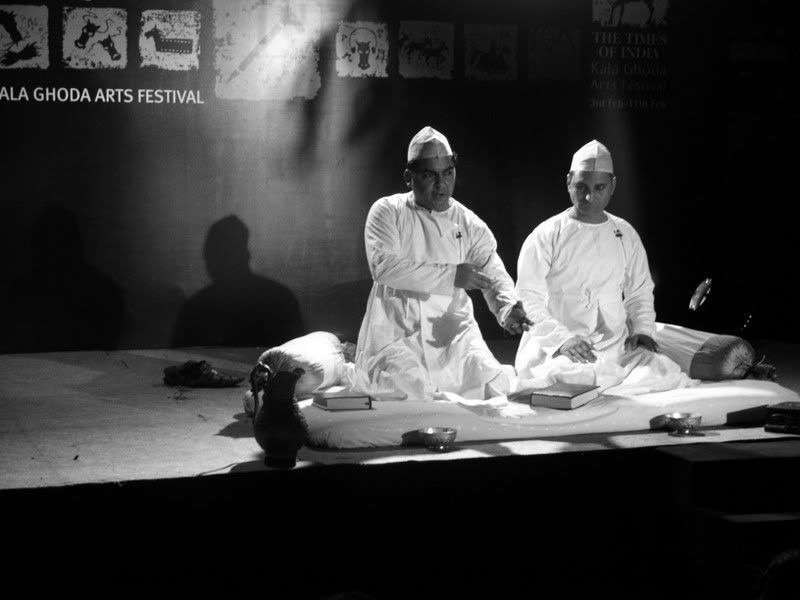
Dastan in The Walled City
We were invited to perform dastan at Balak Mata Centre in Matia Mahal in the Walled City. It has been one of our desires to perform in the Walled City. Though Mahmood once performed on the steps of the Jama Masjid but it was a solo act. It was my first chance to be in the Walled City and I was kicked about it. The place was a portico of an old haveli that has now been converted into a children education centre. Yasmin Sahiba, the director/ principal whatever you may call her of Balak Mata Centre, is a petite enthusiastic lady and had seen our performance at The Attic. She was keen that we perform at her centre's annual function and when Fouzia extended this invitation to us, we readily accepted it. Though the place was noisy with kids fluttering around us, we still loved it. Afterall, the yesteryear dastangos didn't perform to a captive audience. It was an open forum where people walked in and walked out, gossiping, sipping tea, chewing paan, etc.
Our friend G Rajaraman, a sports editor with the Outlook magazine, clicked some photographs. We bring them to you here. :-)
Thanks for supporting us.
Your Dastango,
Danish
 What is he picking upon? Your senses. :-)
What is he picking upon? Your senses. :-)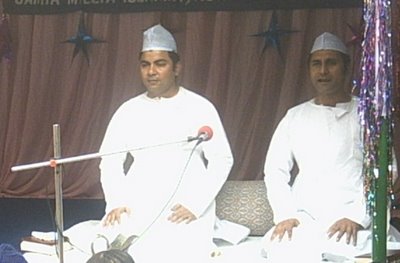 Are you ready for our tales?
Are you ready for our tales? Hindustan Jannat Nishaan.
Hindustan Jannat Nishaan.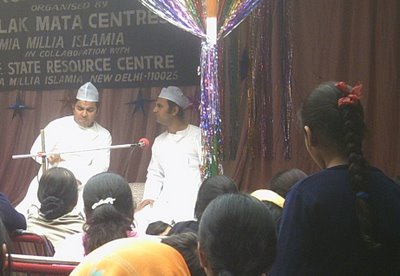 Ok, I've got you now!
Ok, I've got you now! Amar Ayaar concocting a story.
Amar Ayaar concocting a story. A tale being spun.
A tale being spun.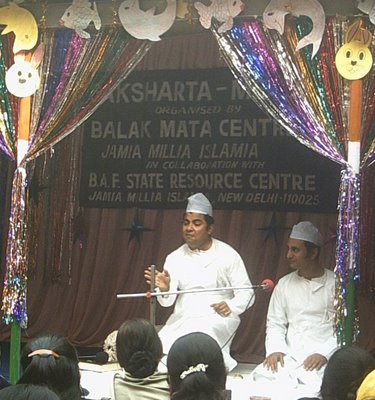 Barq Firangi never tires of his Ayyaari.
Barq Firangi never tires of his Ayyaari.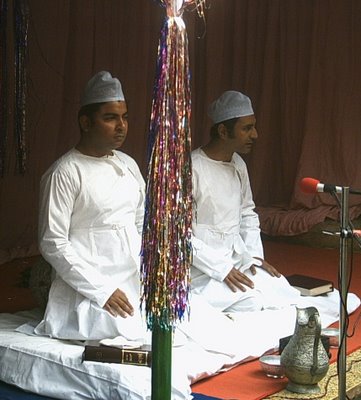 What possibly could be my thoughts? Ah! The Kids!
What possibly could be my thoughts? Ah! The Kids! The tale ends.
The tale ends.
Almost Island Revisited
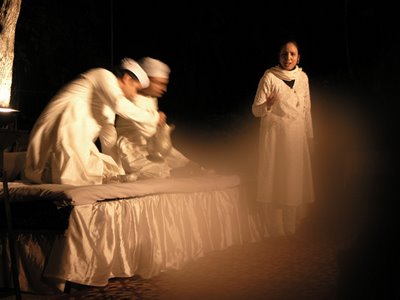 The Preamble
The Preamble The Dastngo's prepare for a performance.
The Dastngo's prepare for a performance.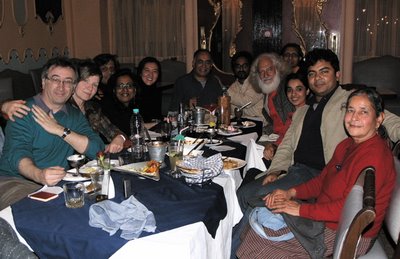 The Post-performance Dinner (From L to R): George Szirtes, Clarissa Upchurch, Munir Mohanty, Sharmistha Mohanty, Nagai Mariko, Ian Allan Sealy, Vivek Narayanan, Arvind Krishna Mehrotra, Kabir Mohanty, Ashwini Bhatt, Danish Husain, Mrs. A.K. Mehrotra.
The Post-performance Dinner (From L to R): George Szirtes, Clarissa Upchurch, Munir Mohanty, Sharmistha Mohanty, Nagai Mariko, Ian Allan Sealy, Vivek Narayanan, Arvind Krishna Mehrotra, Kabir Mohanty, Ashwini Bhatt, Danish Husain, Mrs. A.K. Mehrotra.Photographs courtsey: Clarissa Upchurch





















